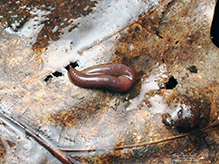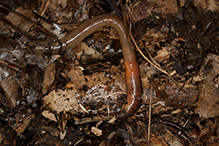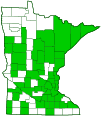common earthworm
(Lumbricus terrestris)
Conservation • Description • Habitat • Biology • Distribution • Taxonomy
|
|
||||||||||||||
Description |
Earthworms are terrestrial, tube-shaped, segmented animals. They are not native to Minnesota. If they ever were, they did not survive the last period of glaciation that ended 11,700 years ago. We do not know if they ever occurred in Minnesota because, having neither an internal skeleton nor an exoskeleton, their bodies do not fossilize. There are at least fifteen species of earthworms found in Minnesota. All of them were imported from Europe and Asia. Common earthworm, also called nightcrawler in the United States, is a common, large earthworm. It is native to western Europe but is now widely distributed throughout the temperate and mildly boreal regions of the world. It is considered invasive outside of its native range, including in Minnesota. Its spread is attributed to human activities, including the movement of soil as ship’s ballast, importation of exotic plants, and disposal of fish bait. It is not the most abundant earthworm in Minnesota but it is the most often encountered. It is a favorite fish bait due to its large size. The body is cylindrical, 4¼″ to 8″ long, and stout, often as thick as a pencil. It is pointed in the front, broad and flattened at the rear. There is no head. The front end, referred to as the head end, is dark brown to reddish-brown, darker in front and fading to the rear. The tail end is light reddish-brown. The dark blood vessel can be seen through the body wall at the upper middle (middorsal) part of the tail end. The body is divided into 120 to 170 segments. Each segment has four pairs of chitinous bristles (chaetae), a lateral pair and a lower (ventral) pair on each side. The chaetae are not visible without strong magnification. They are used to hold parts of the worm in place as other parts elongate, enabling controlled movement. For identification purposes, the four chaetae on each side are referred to as chaeta A, chaeta B, chaeta C, and chaeta D. The distance between C and D is slightly less than between A and B. The first body segment contains the mouth and a fleshy lobe (prostomium) that covers the mouth when at rest. The prostomium contains chemical receptors that function as sensory organs. It is prehensile and can be used to grab an item, such as a grass leaf, and pull it into the worm’s burrow. There are two small furrows on the upper (dorsal) side that reach the boundary between the first and second segments. Separating the head and tail ends there is a thick, differently colored, saddle-like ring (clitellum) around segments 32 through 37. The clitellum is unsegmented but has six rounded lobes corresponding to the underlying segments. It is used to store the worm’s eggs. Like all earthworms, common earthworms have both male and female reproductive organs (hermaphroditic). The male pore, from which sperm is expelled, is on a prominent pad on segment 15. The female pore, from which eggs are released, is on segment 14. |
Size |
Total length: 4¼″ to 8″ |
Similar Species |
Habitat |
|
Biology |
Season |
|
Behavior |
They burrow 1 to 2 meters deep into the soil where they spend the day. They come to the surface at night to feed on leaf litter. |
Life Cycle |
common earthworms copulate on the soil surface at night. |
Food |
Leaf litter |
Distribution |
||
|
Sources |
|
| 12/1/2024 | ||
Occurrence |
||
Common |
||
Taxonomy |
|
Phylum |
Annelida (annelids) |
Class |
Clitellata |
Subclass |
Oligochaeta (earthworms) |
Superorder |
Metagynophora (ITIS) |
Order |
Haplotaxida (Wikipedia – sometimes) Opisthopora (ITIS, Wikipedia – sometimes) Crassiclitellata (COL) |
Suborder |
Lumbricina (earthworms) Crassiclitellata (ITIS) |
Superfamily |
Lumbricoidea |
Family |
Lumbricidae (earthworms) |
Subfamily |
Lumbricinae (NCBI) |
Genus |
Lumbricus |
There is little agreement about the higher taxonomy of earthworms between the ranks of genus and subclass. ITIS, Catalog of Life, NCBI, and iNaturalist all have there own rankings. Wikipedia has different raknings depending how where your search begins. |
|
Subordinate Taxa |
|
|
|
Synonyms |
|
Allolobophora terrestris Aporrectodea terrestris Enterion terrestre Enterion terrestris Lumbricus agricola Lumbricus infelix |
|
Common Names |
|
common earthworm dew worm lob worm nightcrawler |
|
Visitor Photos |
||
Share your photo of this annelid. |
||
This button not working for you? |
||
Alfredo Colon |
||
 |
 |
|
MinnesotaSeasons.com Photos |
||
|
||
|

Slideshows |
|

Visitor Videos |
||
Share your video of this annelid. |
||
This button not working for you? |
||
|
Other Videos |
||
Lumbricus terrestris borrowing |
About
Jan 6, 2016 |
Lumbricus terrestris |
About
Apr 1, 2010 |
Lumbricus terrestris |
About
Oct 9, 2013 Important info from wiki: |
How To Identify Canadian Nightcrawlers Lumbricus Terrestris |
About
Aug 13, 2015 http://www.wormfarmingrevealed.com/ Learn how to identify Canadian Nightcrawlers easily. With just a quick look and ability to identify a few key features you'll know beyond a shadow of a doubt if you have a Canadian Nightcrawler (Lumbricus Terrestris) or not. |

Created: 10/20/2019 Last Updated: © MinnesotaSeasons.com. All rights reserved. |



